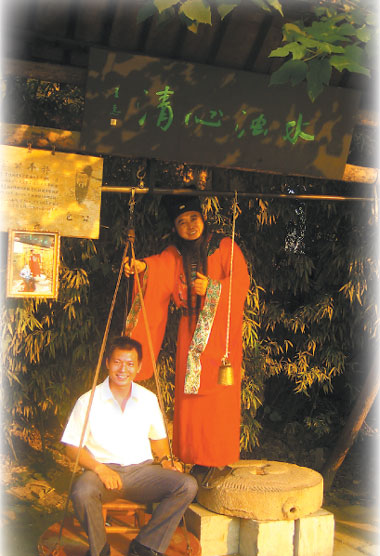Justice, Bao style, dispensed with a smile
 |
| Wang Hui, dressed as Judge Bao, measures the weight of a customer at his stall in the Millennium City Park in Kaifeng. He correctly identifies the young man as having a military background and being disciplined and personable.Wang Shanshan |
But not Wang Hui's reincarnation.
Wang has the imposing physique and presence of Judge Bao, but always wears a winning smile. Dressed in a brighter robe than Bao's traditional garb, he works at a roadside stall in the Millennium City Park, a theme park in Kaifeng, 40 minutes east of Zhengzhou, capital of Henan Province.
The 40-hectare park is a recreation of a scroll painting from the 12th century, Along the River during Qingming Festival (see scroll painting at the top of the page). It is generally considered one of the most significant pieces of fine art in Chinese history. Other than artistic value, it reveals the hustle and bustle of Kaifeng, China's capital city during the Northern Song Dynasty (AD920-1127).
Kaifeng was the center of the nation for seven dynasties. It flourished and became a major metropolis, with a population of 1.5 million, during 168 years of prosperity. The painting captures urban life as it was, and also a large swath of the landscape. By one art historian's account, there are about 550 people, 60 animals, more than 20 boats, about 30 buildings and 20 carts and sedans frozen in a multitude of groupings and activities.
There are several theme parks across China named after the painting, but Kaifeng's has extra authenticity because it is located in the city that was depicted in the scroll. During golden week holidays, the rainbow bridge teems with humanity, just like in the painting.
The park, opened in 1998, is more than just another place of leisure. It wears history on its sleeve. All shopkeepers work in period costumes. Street performers stick to traditional acts, such as spitting fire, throwing daggers around a person, or tossing a red knot into a group of people looking for a spouse.
Likewise, almost everything outside the park is recreation. Even the magnificent 14-km city wall is from the Ming Dynasty (AD1368-1644). So, where are the remnants of the capital city of Northern Song (AD960-1127) and earlier dynasties? The answer: besides those destroyed by war, they are mostly buried.
Between 1180 and 1944, the Yellow River burst its banks 338 times, and flooded Kaifeng seven or eight times. As a result, the city was buried beneath tons of sludge and a new city was built upon it.
For example, four meters beneath Yu Street is a city gate from the Ming Dynasty (AD1368-1644), three meters further down, a gate from the Song Dynasty (AD960-1279), and further down, three more gates.
Surrounded by the splendor of Kaifeng's halcyon days, Wang Hui operates a weight scale. For three yuan (40 cents) he gives the weight of any passerby.
That is more than the usual charge in a shopping mall, but Wang, dressed as Judge Bao, provides an evaluation that no machine can give: as he sits a customer on the scale he recites a limerick that captures the essence and sometimes tells the fortune of that person, sometimes very accurate and always entertaining.
Wang honed his eloquence and humor from decades of experience as chairman of the trade union of a major State-owned enterprise. But when the iron-rice-bowl was shattered, the 48-year-old was thrown into the chaos of a market economy. He first toured the park as a visitor noticing that shopkeepers did not know how best to promote their services and products.
He has 24 poetic verses that fit common physical and personality types. His quickness of wit is apparent. He comes up with words that seem tailor-made for each individual in only a matter of seconds.
Wang does not really tell anyone's fortune. He always puts a positive spin to what he tells each customer, making all of them laugh. "I have a sense of contentment, too, because I'm using my unique skills to support my family," he said.
It took him a year to adapt to his new life as a stall owner and street performer. "I was trained as an engineer in textile technology. When my old colleagues first ran into me in the park, I felt like digging a hole to hide."
Now this Kaifeng native finds himself defending entrepreneurship, which is fueling the rise of the ancient city after hundreds of years of dormancy.
"Yes, this is about tourism, but why not exploit intangible assets left by our ancestors," he asked. "Judge Bao was a native of Kaifeng and is still revered all over the country."
If Wang can take a step down from his position in a State-owned enterprise and thrive again in the new market economy, why cannot an ancient metropolis place its hallowed history on the mantelpiece and blossom into a modern city?
(China Daily 10/19/2007 page25)














